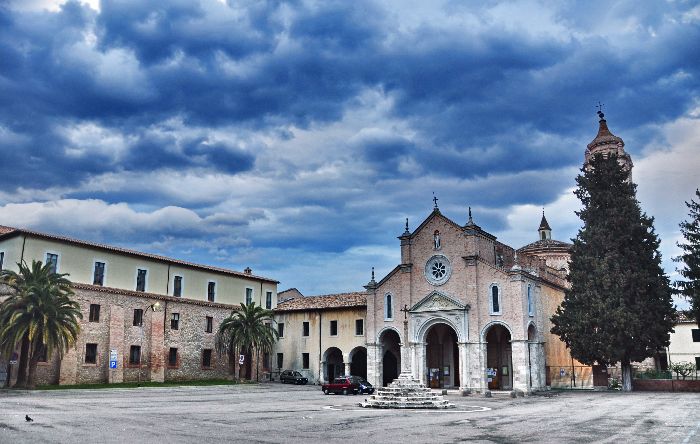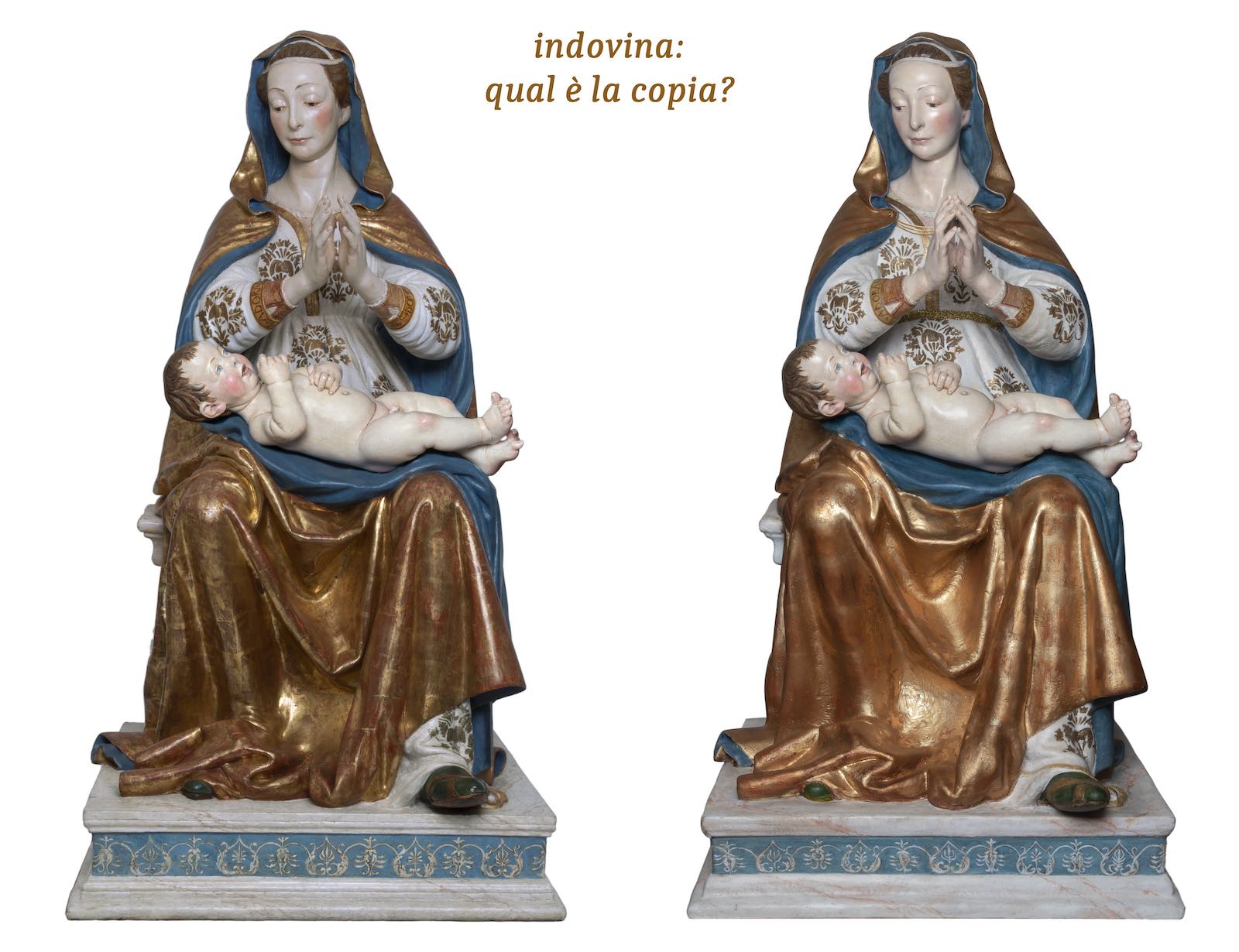


The famous and venerated statue of the Madonna delle Grazie of Teramo left the baton to its stunt double, a very faithful copy, which was delivered at the homonymous city shrine on 21 June 2020, and which on 2 July 2020 walked the streets in procession of the city.
As happens in the cinema, where the actors relegate the most excited and dangerous scenes to the most trained and athletic stuntmen, so these works of art, ancient and precious, should be preserved from situations considered risky, such as, for example, the ritual processions, which they constitute delicate and dangerous moments for the integrity of these assets.

The statue of the Madonna delle Grazie, a polychrome and gilded wooden sculpture, dates back to around 1474, the year in which the works for the adaptation of the convent were completed, and attributed by historians to Silvestro Dell’Aquila. The work fits, with arrogance and undeniable refinement and artistic skill, into the circle of those sculptural artefacts considered to be among the most important and representative examples of the Abruzzese Renaissance, and one of the highest examples of wooden sculpture in Central Italy.

The good depicts a Madonna sitting on a bench, adoring her Child, lying playfully on her maternal knees; the Virgin's mantle is decorated entirely through the application of pure gold leaf, an element that makes this artifact, as well as being very important from a historical and artistic point of view, equally valuable for the materials used in the execution technique.
Beyond its artistic and historical value, the work has always been the object of profound religious devotion, as is the case with every artifact of this type, which indeed was born, in every century, mainly with this purpose, even before being considered an art object.

It is in fact undeniable that faith and popular devotion have always been the main engines of wide-ranging artistic and architectural production, however, precisely this attachment to Christian simulacra has generated, in every century and still today, serious degradation to these works that have fortunately come to us, in more or less happy conditions of conservation depending on the case, and which we have the duty to pass on to posterity in the best possible way.
The history of art is very rich in phenomena of destruction, tampering, alteration of goods, with much more devastating results, perpetrated by the hand of man, compared to the natural and physiological degradation of the constituent materials of art: unfortunately, the greatest damage there we have caused us, and often in good faith, thinking of doing better, to fix a statue or to embellish it.
The ethical guidelines of modern conservation try to balance these two instances, preserving both the historical and artistic aspect and protection of a secular artifact, which represents the identity of a people, and the religious-devotional aspect: the game it is never simple and often involves delicate compromises that aim precisely to support two antithetical factors at the same time. This is why, nowadays, the theme of processions is particularly critical: these are in fact extremely delicate and risky moments for the integrity of a work of art, which is moved and transported by personnel who are not expert on the subject and without adequate tools and precautions, exposing the works to the risk of accidental falls and collisions.
An even more neglected problem, the sudden change of environment (from the church to the outside), is already a danger in itself, since all the materials of the art, being accustomed to certain conditions of temperature and humidity, see the parameters and behave accordingly: environmental variations cause loosening of fabrics, swelling and shrinking of all materials, movements that stress the color of the decorations, with an easily imaginable ending.
This discourse, valid for each work of art, becomes of primary importance and worthy of consideration and prompt resolution for ancient and precious goods such as our Madonna delle Grazie which can no longer afford to be exposed to such a high processional risk, even if practiced only once a year.
At the request of the Friars Minor of the Sanctuary, and for them by the Rector Father Vincenzo Galli, a copy was therefore made, which will replace the original during the processions and all devotional uses that involve risky phases, while the original will remain safe in church, protected and visible regularly.
The long work that reproduced a faithful replica of the statue was the result of a specialized team, all from Abruzzo, who worked in synergy and careful familiarity in the plastic and aesthetic rendering of every detail of the original.
All the processing phases were led by Luca Di Berardino and Sergio Pasqual, of 3dSapiens of Pescara, who first acquired, through about one hundred photographs, all the details and profiles of the statue; subsequently, using photogrammetric techniques, which allow to trace the volumetric geometry of an object, through software, it was possible to reconstruct a 3d model of the work.
The NEL Design laboratory in Corropoli "materialized" the 3D model, by milling blocks of EPS (sintered expanded polystyrene), for the Virgin, while the Bambinello was molded in resin.
At this point, having obtained the statue entirely in white, it was possible to proceed with the aesthetic rendering, entrusted to the decorator Filomena Tavano from Pescara, who hand-painted the entire artifact with acrylic colors, dwelling meticulously in the faithful rendering not only of the original colors, but also of all those elements that make up the "experience" of the work, that is small cracks and cracks in the surfaces, minimal discrepancies and residual patinas in the interstices, and every little detail that the original currently shows and that helps to give the copy fidelity to the original in the ancient patina, without appearing "new".
The gilded areas have been reproduced with pure gold leaf and brass leaf, while some embossed finishes, present on the garments and on the base, have been imitated by making them in stucco.

This meticulous pictorial and plastic attention, combined with a surface finish of the same brilliance as the ancient statue, have led to a result of extreme fidelity to the original, with the addition, not negligible, of the lightening of the overall weight, so that, during the procession, it will be easier to carry the copy.
Valentina Muzii, restorer in Teramo
Sanctuary of the Madonna delle Grazie
Address: Largo Madonna delle Grazie, 64100
Phone: 0861250392
Site:
http://www.paesiteramani.it/Paesi/TeramoMadGrazie.htmLocation inserted by
Luca Di Berardino